
Catfish are a diverse group of ray-finned fish. Named for their prominent barbels, which resemble a cat's whiskers, catfish range in size and behavior from the three largest species alive, the Mekong giant catfish from Southeast Asia, the wels catfish of Eurasia, and the piraíba of South America, to detritivores, and even to a tiny parasitic species commonly called the candiru, Vandellia cirrhosa. Neither the armour-plated types nor the naked types have scales. Despite their name, not all catfish have prominent barbels or "whiskers". Members of the Siluriformes order are defined by features of the skull and swimbladder. Catfish are of considerable commercial importance; many of the larger species are farmed or fished for food. Many of the smaller species, particularly the genus Corydoras, are important in the aquarium hobby. Many catfish are nocturnal, but others are crepuscular or diurnal.

Ancistrus is a genus of nocturnal freshwater fish in the family Loricariidae of order Siluriformes, native to freshwater habitats in South America and Panama. Fish of this genus are common in the aquarium trade where they are known as bushynose or bristlenose catfish. In the aquarium hobby they are often referred to as bushynose or bristlenose plecos instead, but this may lead to confusion as "pleco" usually is used for Hypostomus plecostomus and its allies and is often used as a catchall term for any loricariids remotely resembling that species.

Callichthyidae is a family of catfishes, called armored catfishes due to the two rows of bony plates along the lengths of their bodies. It contains some of the most popular freshwater aquarium fish, such as many species in the genus Corydoras.
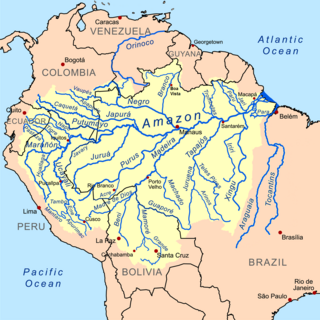
The Amazon basin is the part of South America drained by the Amazon River and its tributaries. The Amazon drainage basin covers an area of about 7,000,000 km2 (2,700,000 sq mi), or about 35.5 percent of the South American continent. It is located in the countries of Bolivia, Brazil, Colombia, Ecuador, Guyana, Peru, Suriname, and Venezuela, as well as the territory of French Guiana.
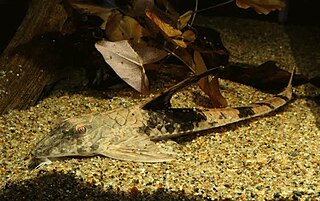
Loricariidae is the largest family of catfish, with 92 genera and just over 680 species. Loricariids originate from freshwater habitats of Costa Rica, Panama, and tropical and subtropical South America. These fish are noted for the bony plates covering their bodies and their suckermouths. Several genera are sold as "plecos", notably the suckermouth catfish, Hypostomus plecostomus, and are popular as aquarium fish.

Corydoras is a genus of freshwater catfish in the family Callichthyidae and subfamily Corydoradinae. The species usually have more restricted areas of endemism than other callichthyids, but the area of distribution of the entire genus almost equals the area of distribution of the family, except for Panama where Corydoras is not present. Corydoras species are distributed in South America where they can be found from the east of the Andes to the Atlantic coast, from Trinidad to the Río de la Plata drainage in northern Argentina. Species assigned to Corydoras display a broad diversity of body shapes and coloration. Corydoras are small fish, ranging from 2.5 to 12 cm in SL., and are protected from predators by their body armor and by their sharp, typically venomous spines.

Corydoras panda is a species of catfish belonging to the genus Corydoras, of the family Callichthyidae, and is a native member of the riverine fauna of South America. It is found in Peru and Ecuador, most notably in the Huánuco region, where it inhabits the Río Aquas, the Río Amarillae, a tributary of the Río Pachitea, and the Río Ucayali river system. The species was first collected by Randolph H. Richards in 1968, and was named Corydoras panda by Nijssen and Isbrücker in 1971. The specific name is an allusion to the appearance of the fish, which possesses large black patches surrounding the eyes, reminiscent of those found on the giant panda. Accordingly, the common names for this fish, which is a popular aquarium species, are panda corydoras and panda catfish.
Cordylancistrus is a genus of suckermouth armored catfish native to South America. It is much the same as Chaetostoma. The few differences are a wider head, longer cheek odontodes, and plates on the snout. Cordylancistrus can be found in rivers and streams high in the Andes, from Venezuela to Colombia.
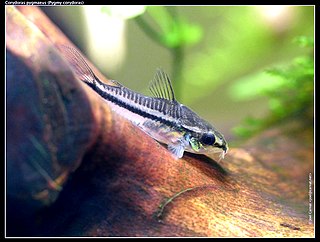
Corydoras pygmaeus, or the pygmy corydoras or pygmy catfish is a tropical and freshwater fish belonging to the subfamily Corydoradinae of the family Callichthyidae. It originates in tropical inland waters in South America, and is found in the Madeira River basin in Brazil.
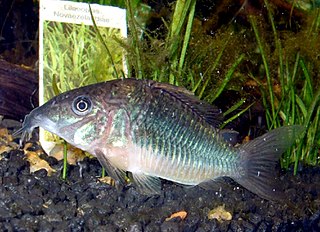
The emerald catfish is a tropical freshwater fish belonging to the Corydoradinae sub-family of the family Callichthyidae native to the Amazon Basin in South America. It has traditionally been known as Brochis splendens. The fish has appeared on a stamp in Brazil.
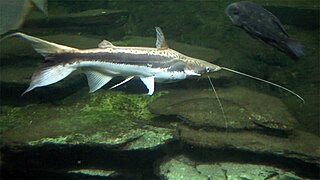
Sorubim is a small genus of long-whiskered catfish native to tropical South America. A number of characteristics allows the differentiation of each species in the genus. Sorubim species are important food fish in South America and are highly significant to fisheries of some areas; however, harvests of these fish are not identified as much as other, more popular food fishes such as Colossoma, Arapaima, and Brachyplatystoma. Some species of this family are popular aquarium fish.

Hemiancistrus is a genus of suckermouth armored catfishes. These species are native to South America. The taxonomy of this genus is complex and unclear, and major work has to be done. Many of these fish are popular aquarium fish.

Loricaria is a genus of armored catfish native to South America.

Ancistrini is a tribe of catfishes of the family Loricariidae. Most are restricted to tropical and subtropical South America, but there are also several genus in southern Central America.
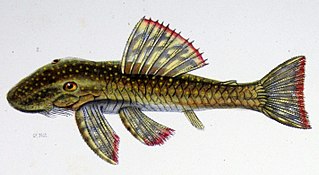
Lasiancistrus is a genus of suckermouth armored catfishes. They are native to South America and Panama.

Cavefish or cave fish is a generic term for fresh and brackish water fish adapted to life in caves and other underground habitats. Related terms are subterranean fish, troglomorphic fish, troglobitic fish, stygobitic fish, phreatic fish, and hypogean fish.

Chaetostoma, also known as the bristlemouth catfish, is a genus of suckermouth armored catfishes native to South America with one species, C. fischeri, extending into Panama. Most species inhabit flowing rivers in the lower Andes and its foothills. Some species are kept in unheated aquaria.
Chaetostoma carrioni is a species of armored catfish from South America. These fish reach 7.8 centimetres (3.1 in) SL. These fish are demersal and live in tropical, freshwater habitats. They are found in the Marañón River basin in Ecuador.
Andeancistrus is a genus of suckermouth armored catfishes native to South America. This genus is diagnosable from all other members of the Chaetostoma group by having a fully plated snout, lacking cheek odontodes that extend past the opercular flap, and by having eight branched dorsal fin rays.
Chaetostoma platyrhynchus is a species of catfish in the family Loricariidae. It is native to South America, where it occurs in the Caquetá River basin in Colombia. The species reaches 9.5 cm in total length. The species is known to be of disputed classification and spelling.
















